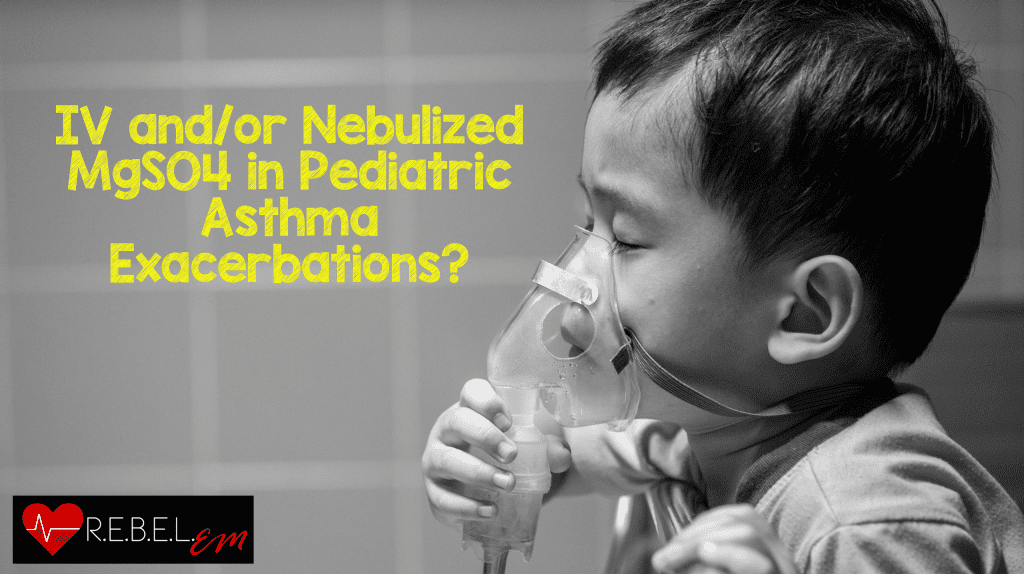
 Background: Acute asthma exacerbations are a common presentation to pediatric emergency departments (EDs). Standard treatment with inhaled beta agonists and corticosteroids are often sufficient in mild asthma but can fall short in the treatment of moderate to severe exacerbations. Magnesium sulfate (MgSO4) has long been touted as an adjunct treatment due to its bronchodilatory properties (both in its intravenous (IV) and nebulized form). Despite its routine use, the evidence for its benefit is inconsistent, particularly in the adult population where the most recent large RCT demonstrated modest benefits (Goodacre 2013).
Background: Acute asthma exacerbations are a common presentation to pediatric emergency departments (EDs). Standard treatment with inhaled beta agonists and corticosteroids are often sufficient in mild asthma but can fall short in the treatment of moderate to severe exacerbations. Magnesium sulfate (MgSO4) has long been touted as an adjunct treatment due to its bronchodilatory properties (both in its intravenous (IV) and nebulized form). Despite its routine use, the evidence for its benefit is inconsistent, particularly in the adult population where the most recent large RCT demonstrated modest benefits (Goodacre 2013).
Article
Su Z et al. Intravenous and nebulized magnesium sulfate for treating acute asthma in children: a systematic review and meta-analysis. Pediatr Emer Care 2018; 35: 390-5. PMID: 29851914
Clinical Question:
Does the addition of intravenous or nebulized magnesium sulfate to routine treatment improve outcomes in pediatric patients with asthma exacerbations?
Population: Randomized and quasi-randomized controlled trials of IV or nebulized magnesium in the treatment of pediatric (< 18 years of age) acute asthma exacerbations. Medline, Cochrane Library and EMBASE were searched for relevant articles.
Outcomes: Improvement in pulmonary function, hospitalization and additional treatment.
Design: Meta-analysis and systematic review of randomized and quasi-randomized trials
Excluded: Reviews and case reports, trials of adult patients (> 18 years), trials comparing MgSO4 with beta-agonists
Results:
-
84 articles were identified and, ultimately, 10 included in this systematic review and meta-analysis
- Six articles (n = 325) investigating IV MgSO4
- Four articles (n = 870) investigating nebulized MgSO4
- Authors utilized risk ratio (RR) to express dichotomous outcomes of hospitalization and further treatment
- Authors utilized standardized mean difference (SMD) for pulmonary function where an SMD > 0.8 represents a large difference and an SMD = 0 represents no difference.
Critical Results:
-
Intravenous MgSO4
-
Hospital admission
- IV MgSO4 led to a decrease in hospital admission
- RR 0.55 (95% CI 0.31 – 0.95 p = 0.03)
-
Pulmonary function
- IV MgSO4 led to a significant improvement in pulmonary function
- SDM = 1.94 (95% CI 0.80 – 3.08 p = 0.0008)
-
Hospital admission
-
Nebulized MgSO4
-
Hospital admission
- Nebulized MgSO4 had no significant effect on hospital admission
- RR 1.11 (95% CI 0.86 – 1.44)
-
Pulmonary function
- Nebulized MgSO4 had no significant effect on pulmonary function
- SMD 0.19 (95% CI – 0.01 – 0.40)
-
Hospital admission
Strengths:
- Study asks a clinically important question with patient centered outcomes
- Cochrane Collaboration tool was used to assess the methodological quality of included trials
- Three major databases were reviewed for relevant articles
- All articles screened independently by two reviewers
- IV MgSO4 studies focused on moderate to severe exacerbations
- Heterogeneity was low for hospital admission outcome for both IV and nebulized MgSO4 studies
Limitations:
- A structured tool (i.e. PRISMA guidelines) was not utilized
- Heterogeneity was moderate to high for pulmonary function outcome for both IV and nebulized MgSO4 studies
- IV MgSO4 dosing was variable. Most studies had a max of 2 grams. Some studies have shown a benefit to higher doses (Irazuzta 2016)
- Acuity of illness variable in the nebulized MgSO4 studies
- Most individual studies were small (7/10 studies with n < 100)
- Many of the co-interventions used in the IV and nebulized magnesium sulfate studies were not stated making it difficult to conclude if other interventions could have potentially been the difference
Discussion:
- The British thoracic Society/Scottish Intercollegiate Guideline Network Guidelines 2014 state that IV magnesium sulfate is safe but its place in management is not yet established. Nebulized magnesium sulfate however, is not recommended for treatment of mild to moderate asthma attacks, but in patients presenting with oxygen saturations <92%, adding 150mg magnesium sulfate to each nebulized salbutamol and ipratropium was recommended (evidence C).
Author’s Conclusions:
“The meta-analysis revealed that IV magnesium sulfate is an effective treatment in children, with the pulmonary function significantly improved and hospitalization and further treatment decreased. But nebulized magnesium sulfate treatment showed no significant effect on respiratory function or hospital admission and further treatment.”
Our Conclusion:
We agree with the author’s conclusions. IV magnesium sulfate appears to benefit pediatric patients with moderate to severe asthma with improvements in respiratory function and decreased need for hospitalization. Additional larger studies as well as studies looking at the benefit of higher doses of magnesium sulfate would be helpful.
Potential to Impact Current Practice:
IV MgSO4 should be continued to be used in addition to standard therapy (inhaled beta agonists and systemic corticosteroids) in pediatric patients with moderate to severe asthma.
Clinical Bottom Line:
IV MgSO4 but not nebulized MgSO4 appears beneficial in the treatment of moderate to severe asthma.
References:
- Goodacre S et al. Intravenous or nebulised magnesium sulphate versus standard therapy for severe acute asthma (3Mg trial): a double-blind, randomised controlled trial. Lancet Resp Med 2013; 1(4): 293-300. PMID: 24429154
- Irazuzta JE et al. High-dose magnesium sulfate infusion for severe asthma in the emergency department: efficacy study. Crit Care Med 2016; 17(2): e29-33. PMID: 26649938
Post Peer Reviewed By: Salim R. Rezaie, MD (Twitter: @srrezaie)
The post IV and/or Nebulized MgSO4 in Pediatric Asthma Exacerbations? appeared first on REBEL EM - Emergency Medicine Blog.
